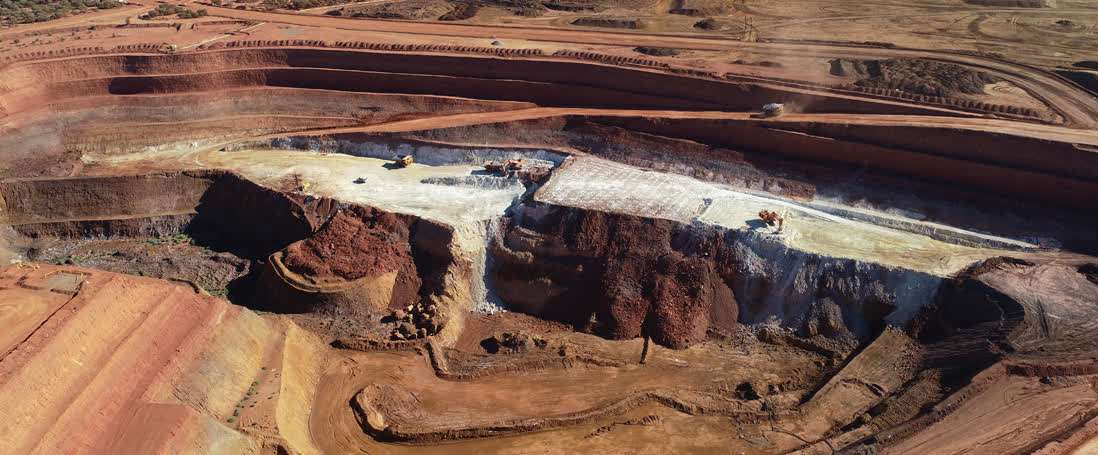[ad_1]

Antoine2K/iStock via Getty Images

Lynas Rare-Earths Mine, Western Australia (Lynas. I contacted the corporation.)
Above: Lynas Rare-Earths Mine in Western Australia
REMX
Is a Well-Diversified Fund of Rare-Earth, Lithium, Cobalt, Zircon, Antimony, Ferronickel, Tungsten, and Boron Mining/Processing
You probably remember your high-school chemistry teacher explaining the periodic table of the elements, usually emphasizing those like hydrogen, oxygen, and carbon which are used the most in our everyday lives. Most science teachers spend little or no time on the lesser-known elements because their chemistry is more complicated and their applications tend to be highly-specialized functions. In modern times the proliferation of cell phones, laptops, automobiles, and nearly all other computerized devices require these “weird” elements in order to function optimally. Many of them have no substitutes. The dramatic increase in the global need for these kinds of elements and their alloys has made their mining and processing an essential part of our modern supply chain.
REMX is invested in twenty different companies which either extract or process these elements or both. They are located around the world, creating an impressive geographic diversity but increasing political risk since some of these mines are located in countries where rulers may increase taxes or fees required to conduct mining operations. Corruption is a problem as many of these so-called fees are bribes in disguise. Even in politically-friendly countries the demands of any mining operation can often be unpredictable, with certain ores being unexpectedly difficult to use for extraction or requiring unexpected expense in doing so. This high level of uncertainty makes it advantageous to invest in an exchange-traded fund like REMX where the risk can be diversified among a basket of these companies, each one producing a different mix of minerals.
REMX Achieved a Nine-Year Peak at the End of November 2021

REMX Since inception (StockCharts.com)
As with many funds of non-precious mining shares, REMX has gained dramatically from its March 2020 bottom. October 27, 2010 was the inception date for REMX which was followed by a peak at 249.35 (all numbers adjusted for dividends using StockCharts.com) on April 11, 2011. Also like many other commodity-related assets, REMX suffered a severe bear market before it bottomed at 26.02 on January 20, 2016. REMX rebounded to 81.79 by January 16, 2018 before suffering another bear market and sliding to its all-time nadir of 22.46 on March 16, 2020. Since then, REMX has climbed as high as its intraday zenith of 119.45 on November 30, 2021 which marked its highest price since the beginning of 2013.
REMX Has a Reasonable Expense Ratio, Total Market Capitalization, and Consistency
REMX has a net annualized expense ratio of 0.59%. The total market capitalization as of the close on February 22, 2022 had been 958.6 million U.S. dollars. The fund has maintained a consistent focus on this industry group throughout its history.
You can find more details about REMX at the fund sponsor’s web site which can be found here:
REMX Overview
REMX’s Huge Gains Have Made It Dangerously Overvalued
Using the numbers listed above you can compute the total bottom-to-top increase from March 2020 through November 2021 which was 431.83% in less than two years. This is excellent news for those who were buyers two years ago, but not so good for those who piled into this fund during the past year. Excessive inflows are hardly unique to REMX as their better-known counterparts including SPY and QQQ had experienced greater net inflows in 2021 than their combined net inflows from 2001 through 2020 combined. It is possible that one day REMX will approach its all-time 2011 top, but between now and then it is likely that a significant amount of the gains of the past two years will be retraced.
The financial media were mostly very negative toward this industry whenever it was ideal to purchase REMX, and provided optimistic commentary whenever it was a good time to sell. As you can see from the above data, REMX has especially dramatic bull and bear markets and should therefore be bought or sold every few years instead of being used as a multi-decade buy-and-hold investment.
REMX’s Fundamentals Are Mediocre on a Long-Term Basis
As of the close on February 22, 2022, REMX featured a price-earnings ratio of 12.93 and a price-to-book reading of 5.31. Both are notably above their median levels of recent years, although they had been higher a decade ago. As a staunch value investor I would strongly prefer to wait for readings which are closer to their lowest historic percentiles.
It Is Untimely to Purchase Non-Depressed Assets During a Major Bear Market
As a general rule one should gradually buy into the most-extended weaknesses during a bear market, but at all times one should only buy assets where the annualized profit growth significantly exceeds the price-earnings ratio. I strongly believe that we began a historic percentage pullback for large-cap U.S. growth shares which has been accompanied by dramatic losses for lesser-known equities. Almost half of all Nasdaq stocks have dropped over 50% from their 2021 highs. I have been recently adding to my long positions in those assets which have the highest ratios of annualized profit growth to price-earnings ratios, most recently including KWEB (Chinese internet), XBI (U.S. biotech), T (AT&T), INTC (Intel), RSX (Russia), while last week I was progressively accumulating TLT (long-dated U.S. Treasuries).
Buy I Bonds Using Your Maximum Annual Allocation of 65K Per married Couple or 35K if You Are Single
I have been consistently buying I Bonds (inflation-linked U.S. government bonds) with the maximum annual allocation per married couple of 65 thousand U.S. dollars per calendar year, currently paying 7.12% annualized. Here is how you get 65 thousand: 10 thousand each in 1) your name; 2) your spouse’s name; 3) your revocable living trust; 4) your spouse’s revocable living trust; 5) your business; 6) your spouse’s business; 7) overpaying your federal estimated income tax and applying five thousand of your federal refund toward I Bonds.
Fortunately We Have Useful Signals for Buying REMX at Its Next Bottom
Whenever we reach a worthwhile bottoming pattern for REMX we are likely to experience all of the following: 1) frequent intraday lows shortly after the opening bell, indicating that the least-experienced investors who trade early in the day are bailing out; 2) reliable insider buying which takes more work to identify for REMX because o
f its diversified geography; 3) frequent net outflows by disappointed investors; 4) more persistently negative media coverage of this sector; and 5) recent extended downtrends for other non-precious commodity producers. There will probably also be frequent internet commentary asking “how much lower is REMX going to fall” and similar fears about related assets which often indicate that a major rally is imminent.
The past, as usual, is your most accurate guide to the future. Whenever we next experience the environment we had experienced for REMX in January 2016 and March 2020, it will likely provide another rewarding buying opportunity for REMX.
Disclosure of All Securities Owned
I have the following long positions, from largest to smallest in my portfolio: cash and its equivalents including I Bonds, TLT (NEW), GDXJ, GEO, GDX, KWEB (NEW), EWZ, TUR, XBI (NEW), ASA, ECH, T (NEW), INTC (NEW), RSX (NEW), UGP, ITUB, BBD, TIMB.
These are my short positions also from largest to smallest: XLK, QQQ, TSLA, AAPL, IWF, SMH.
[ad_2]
Source links Google News

